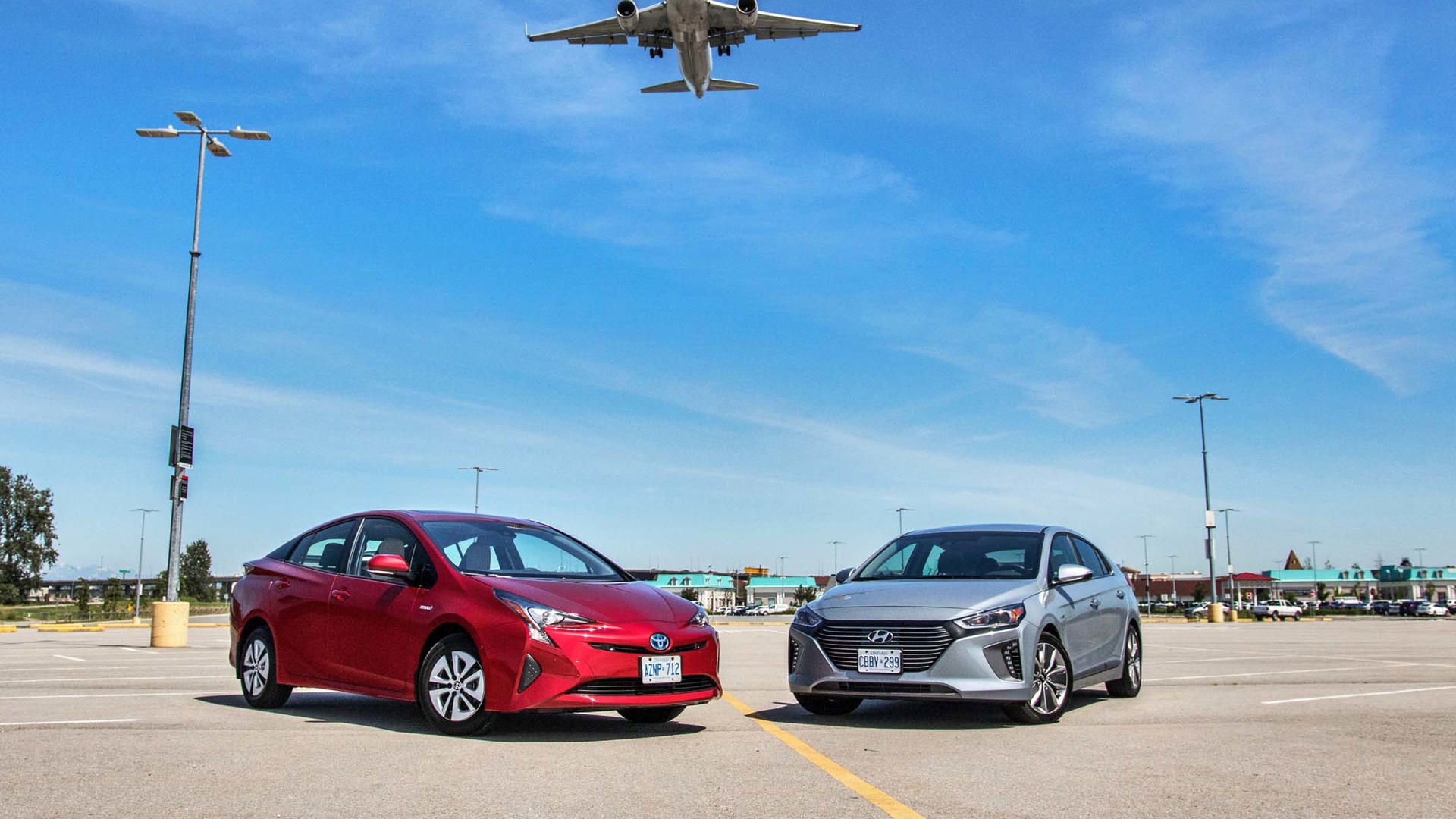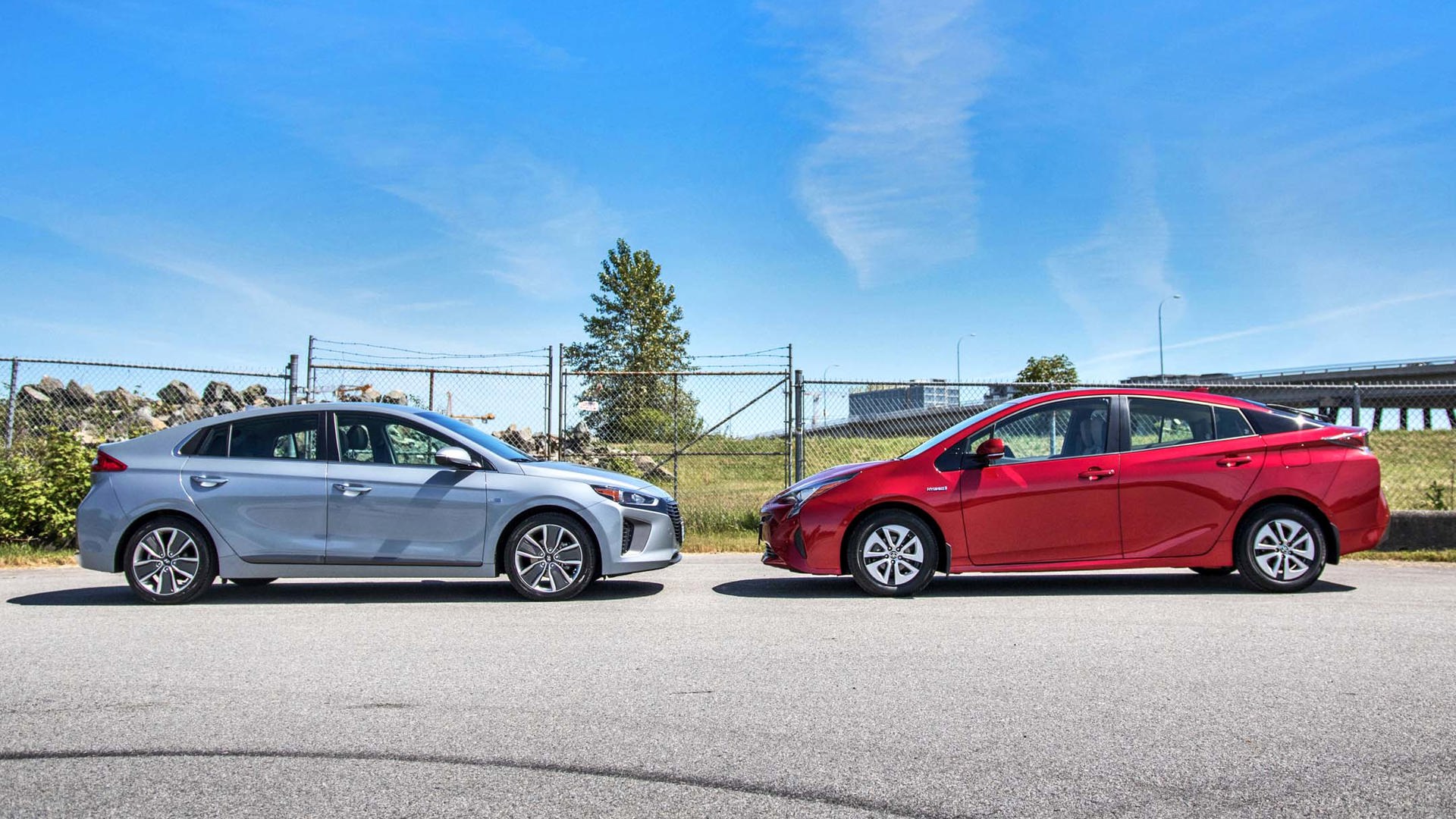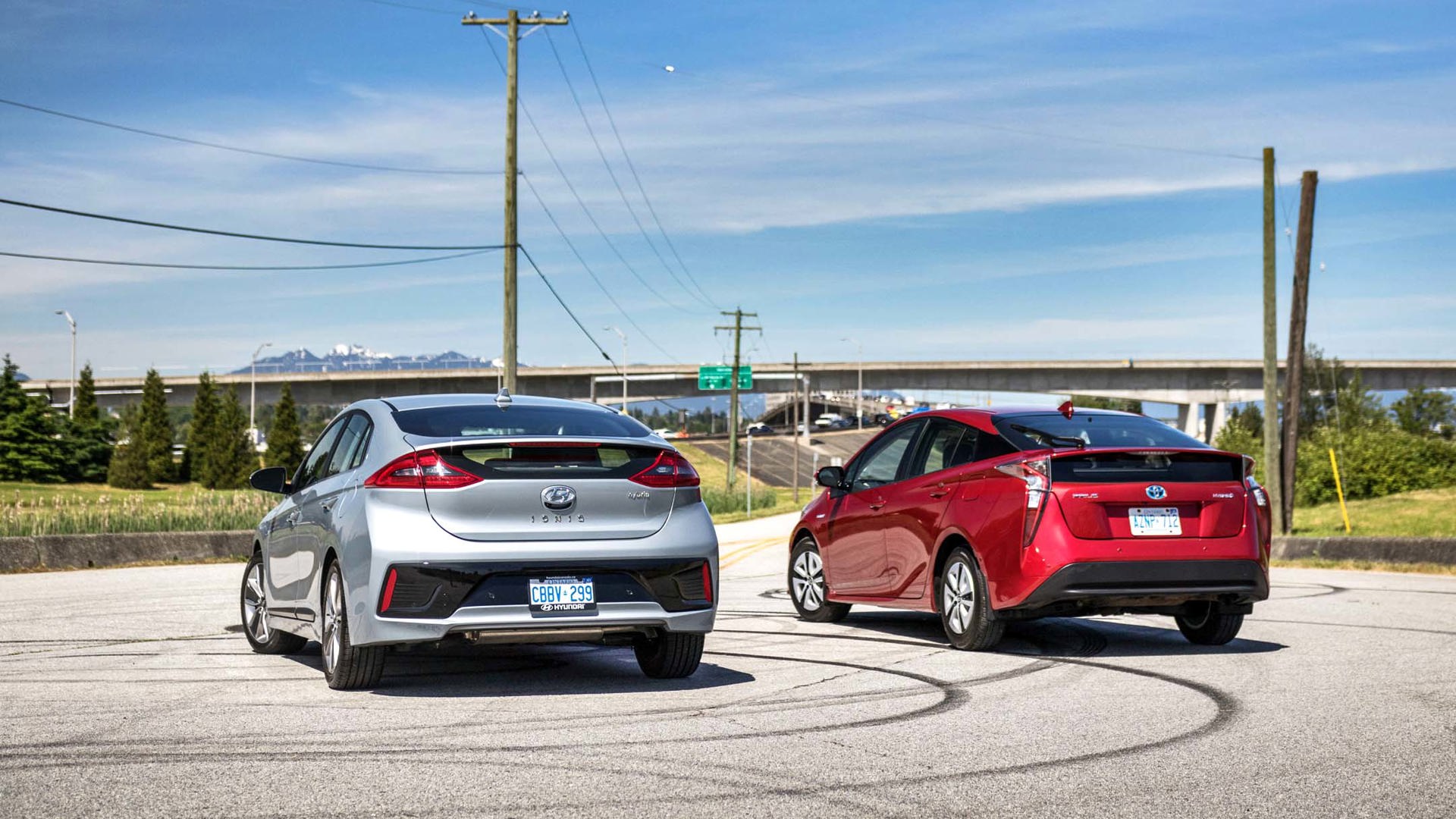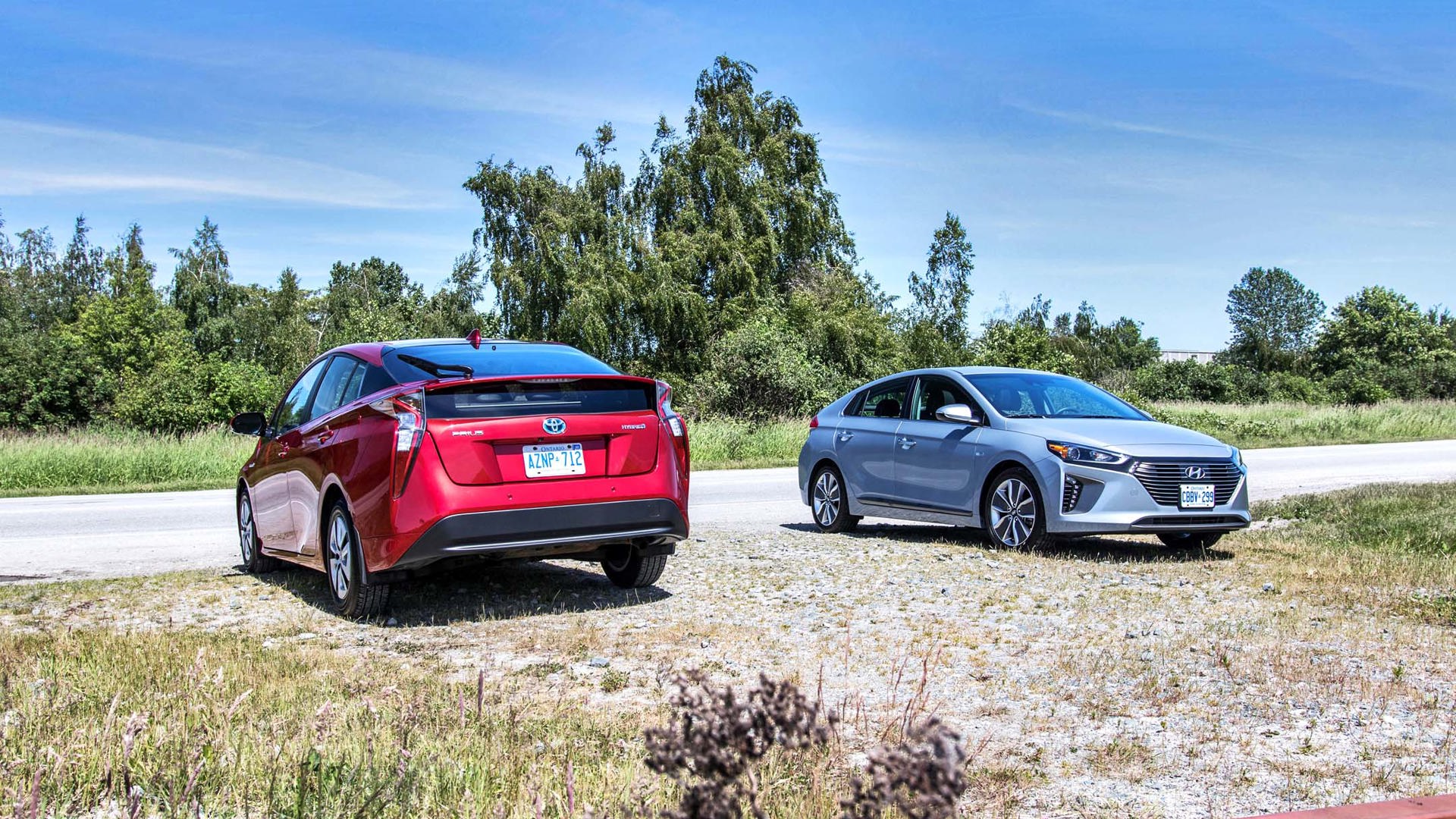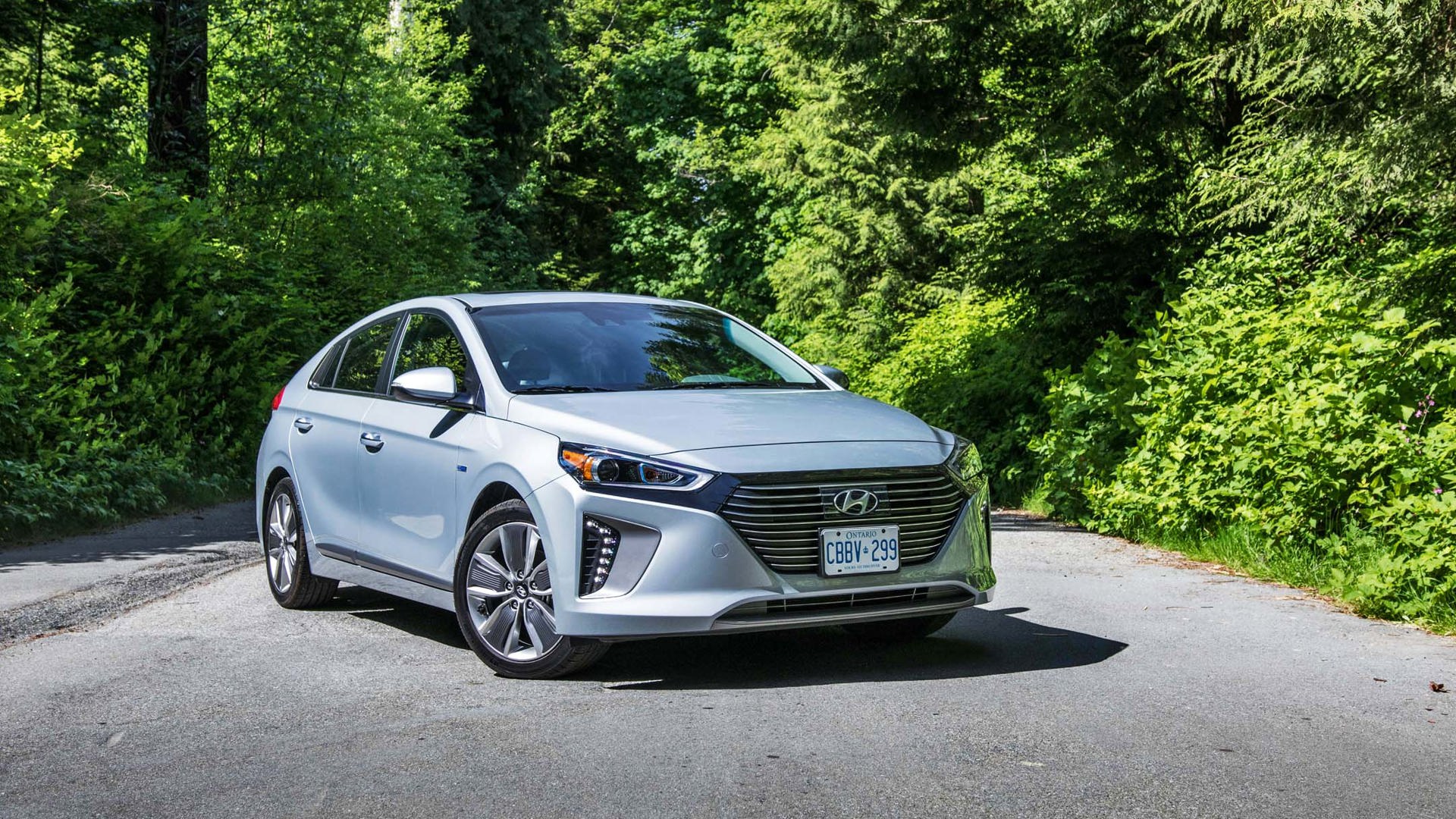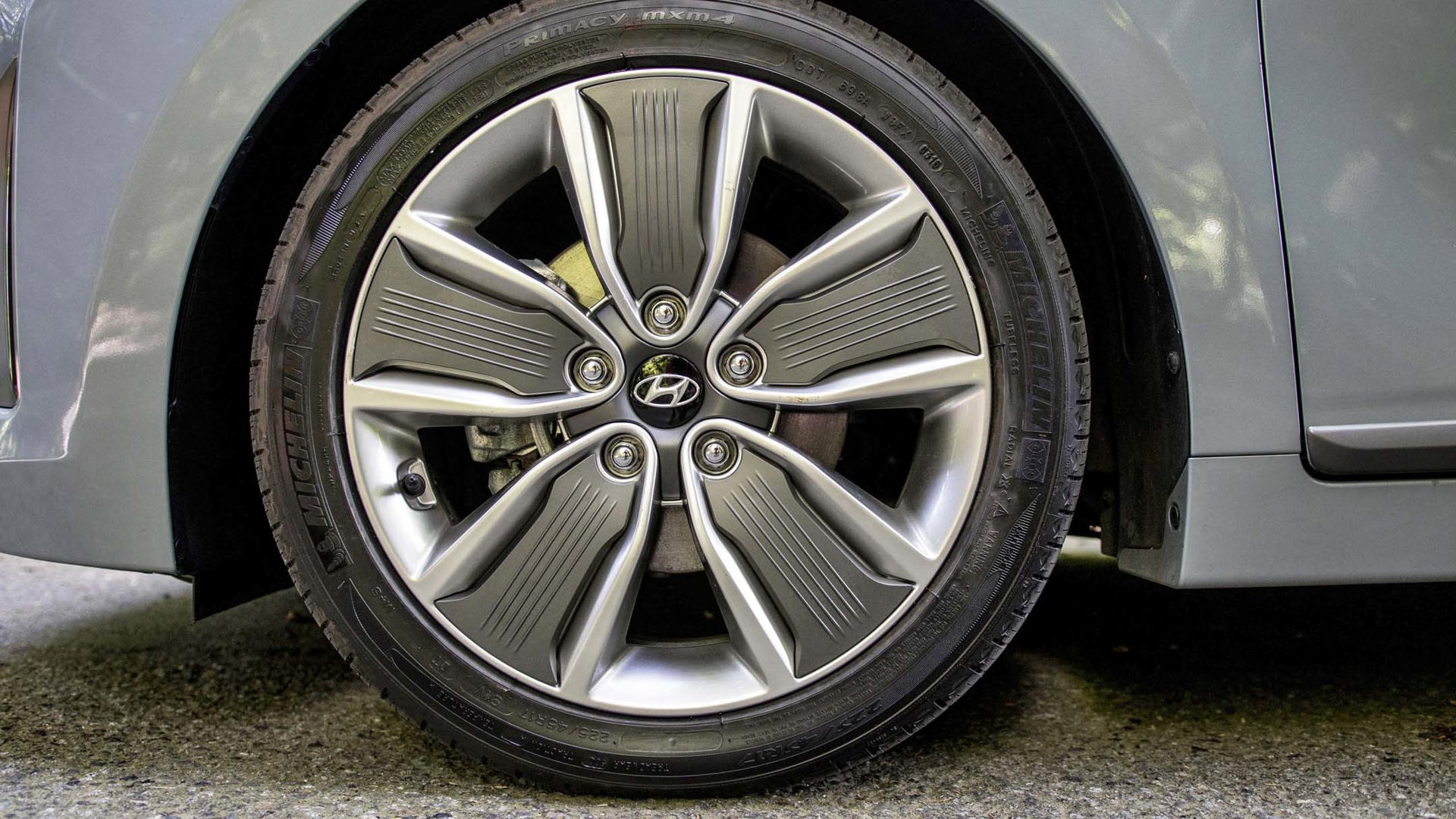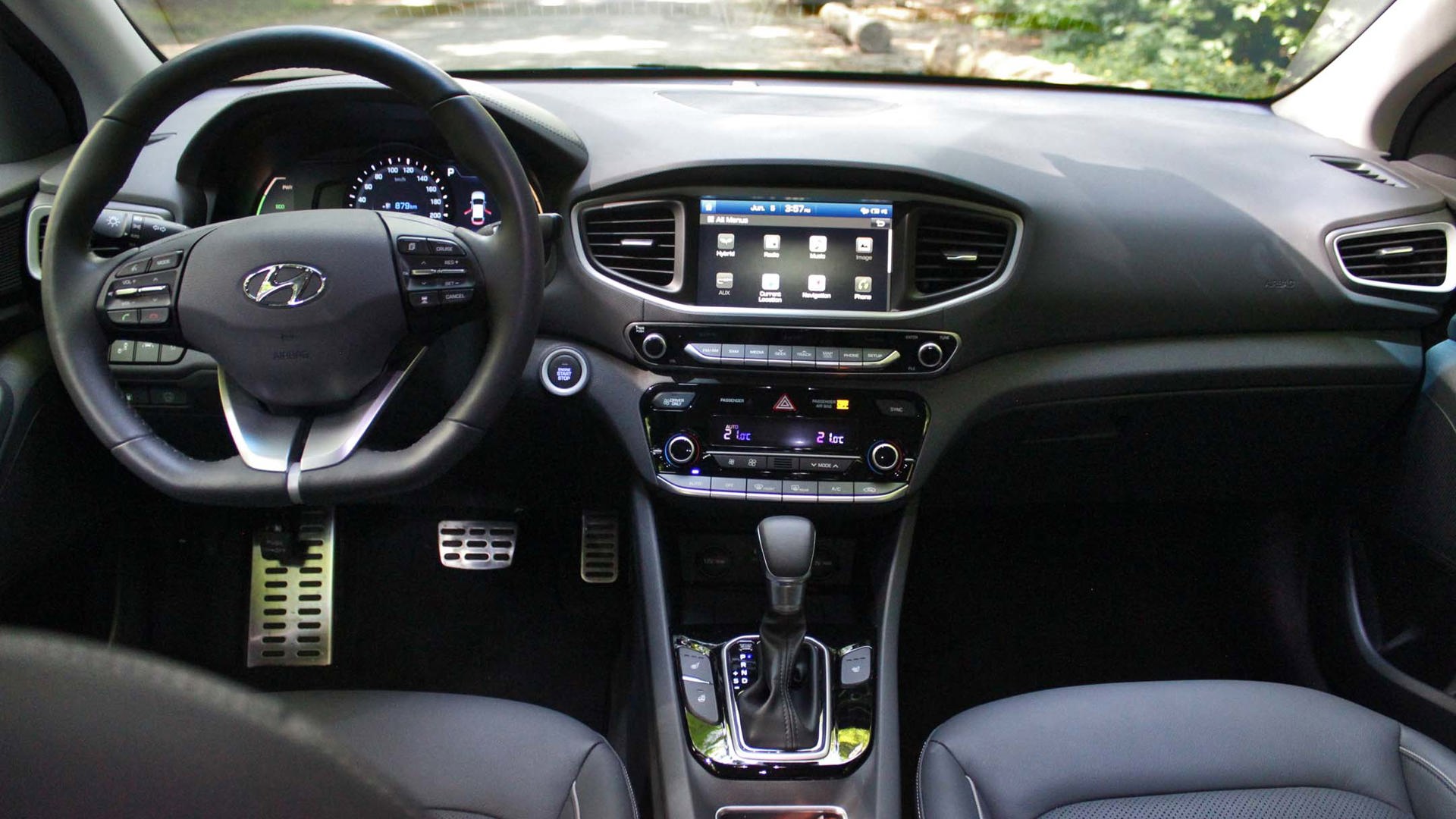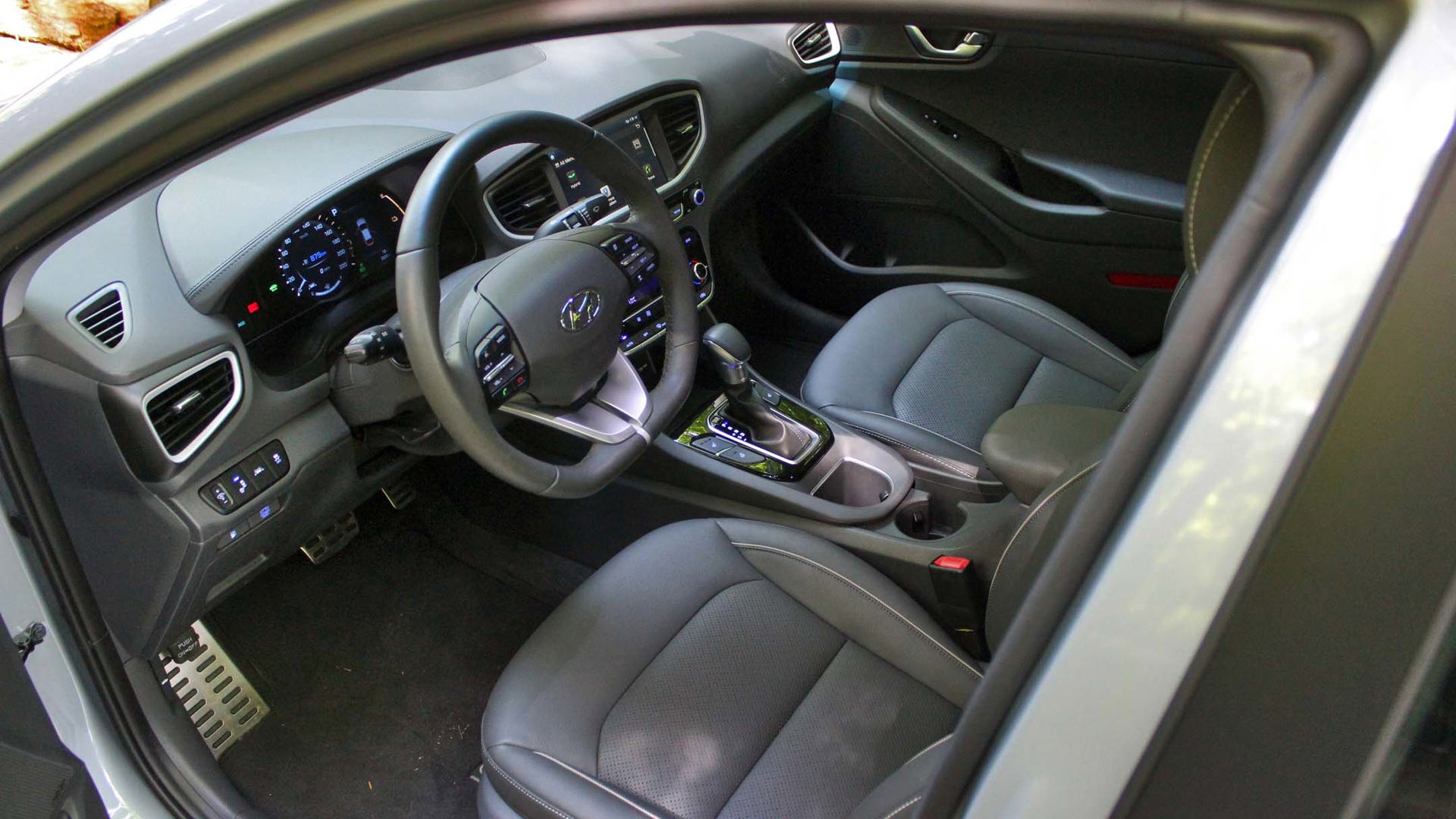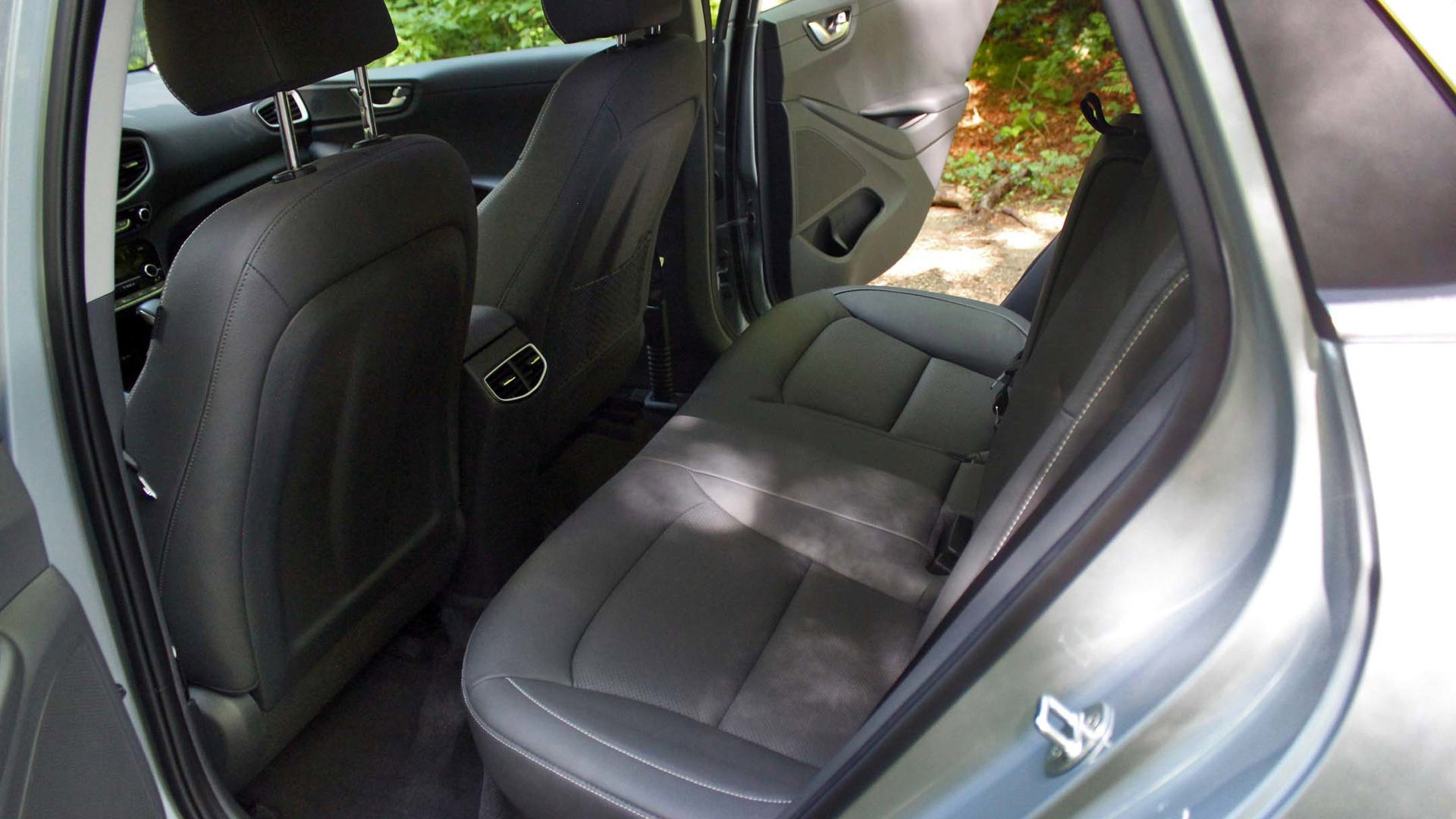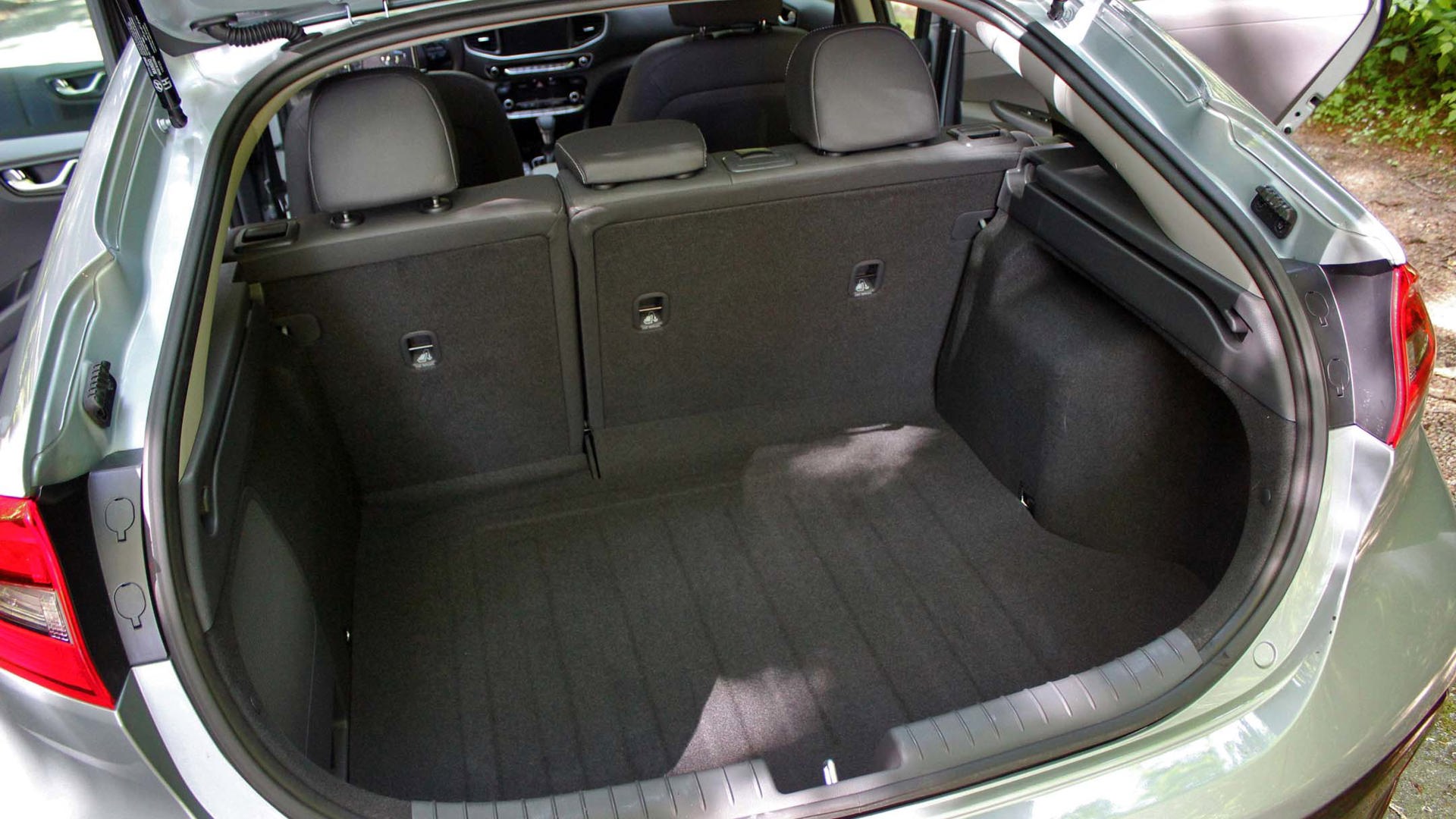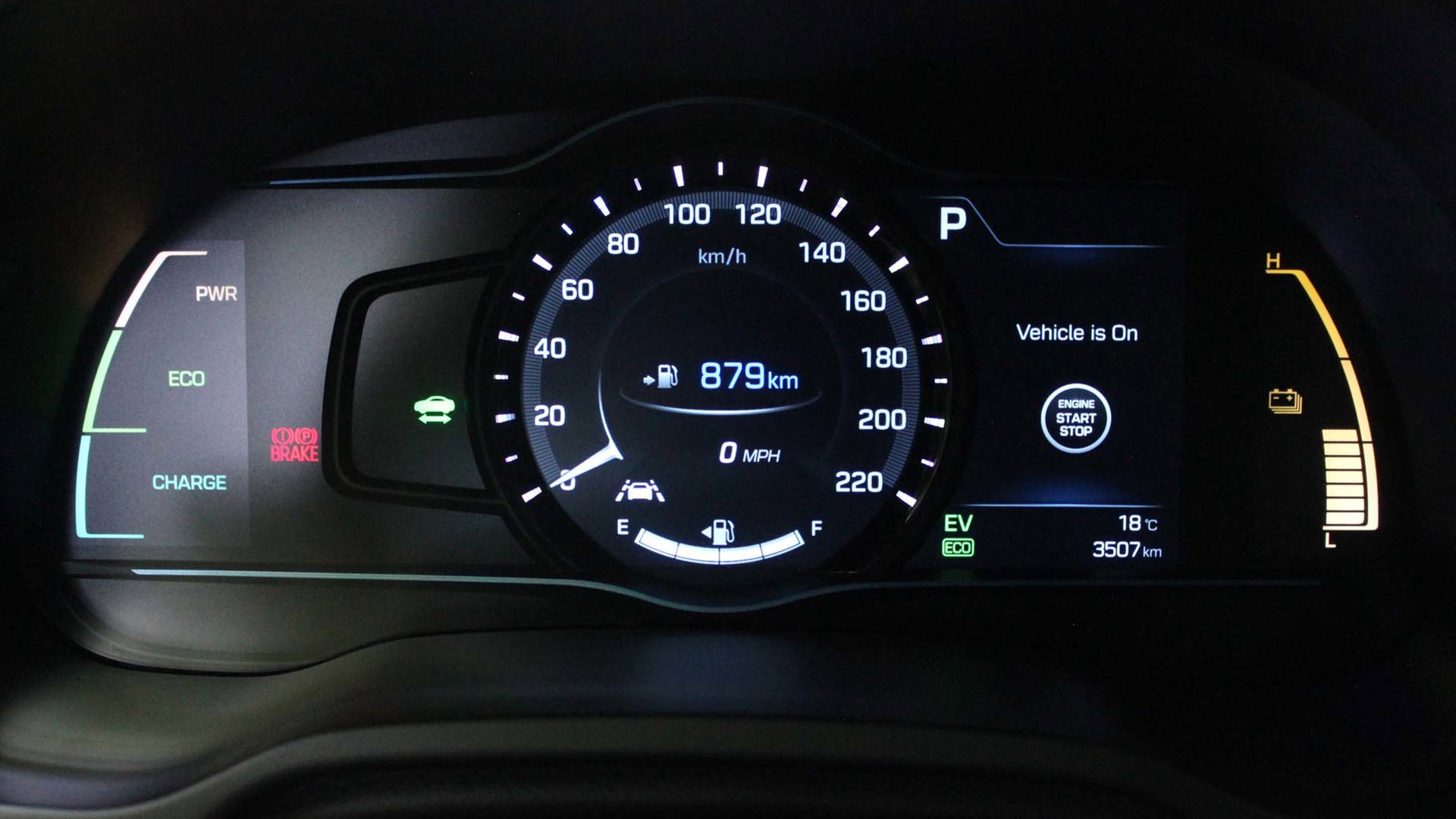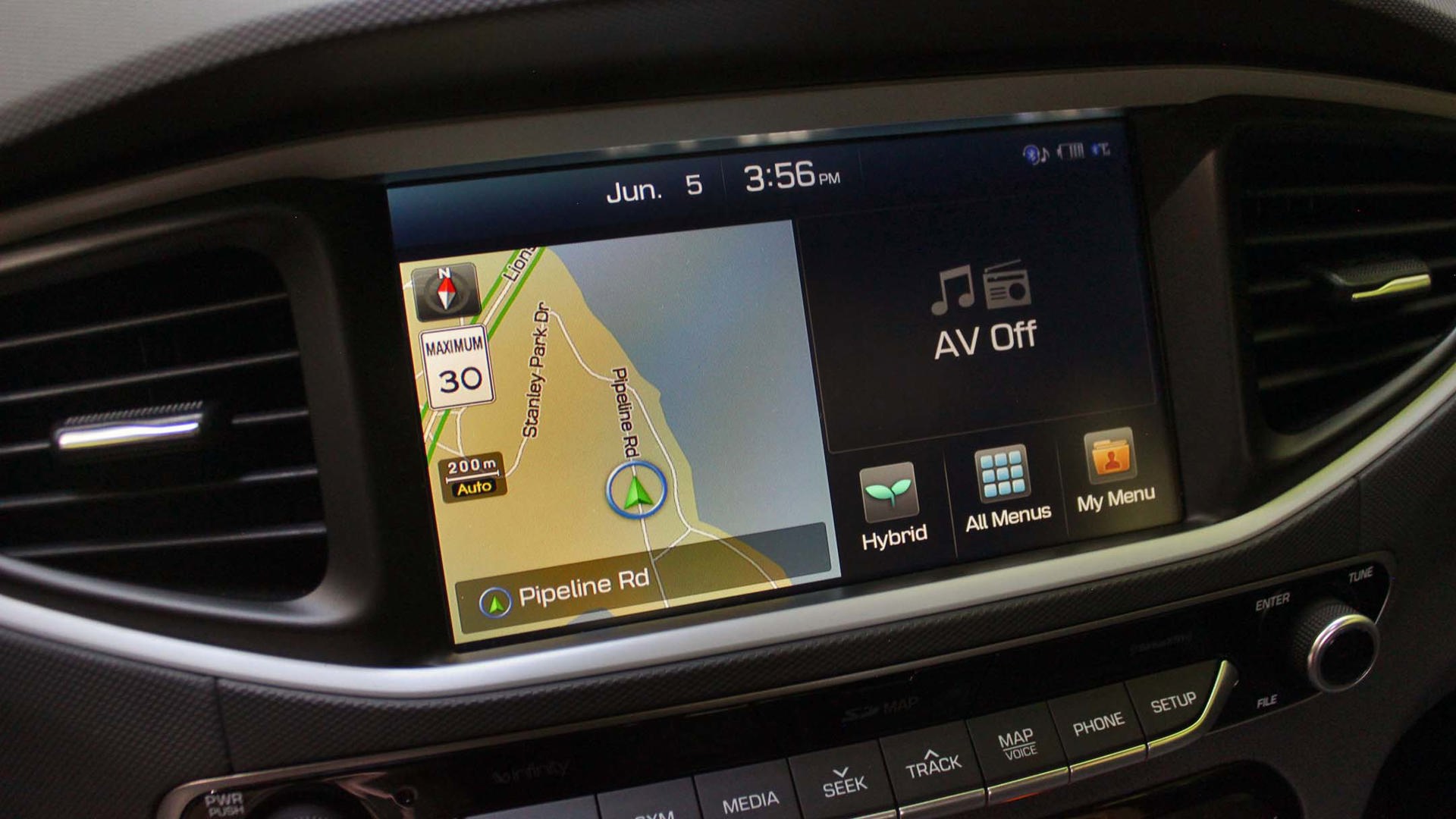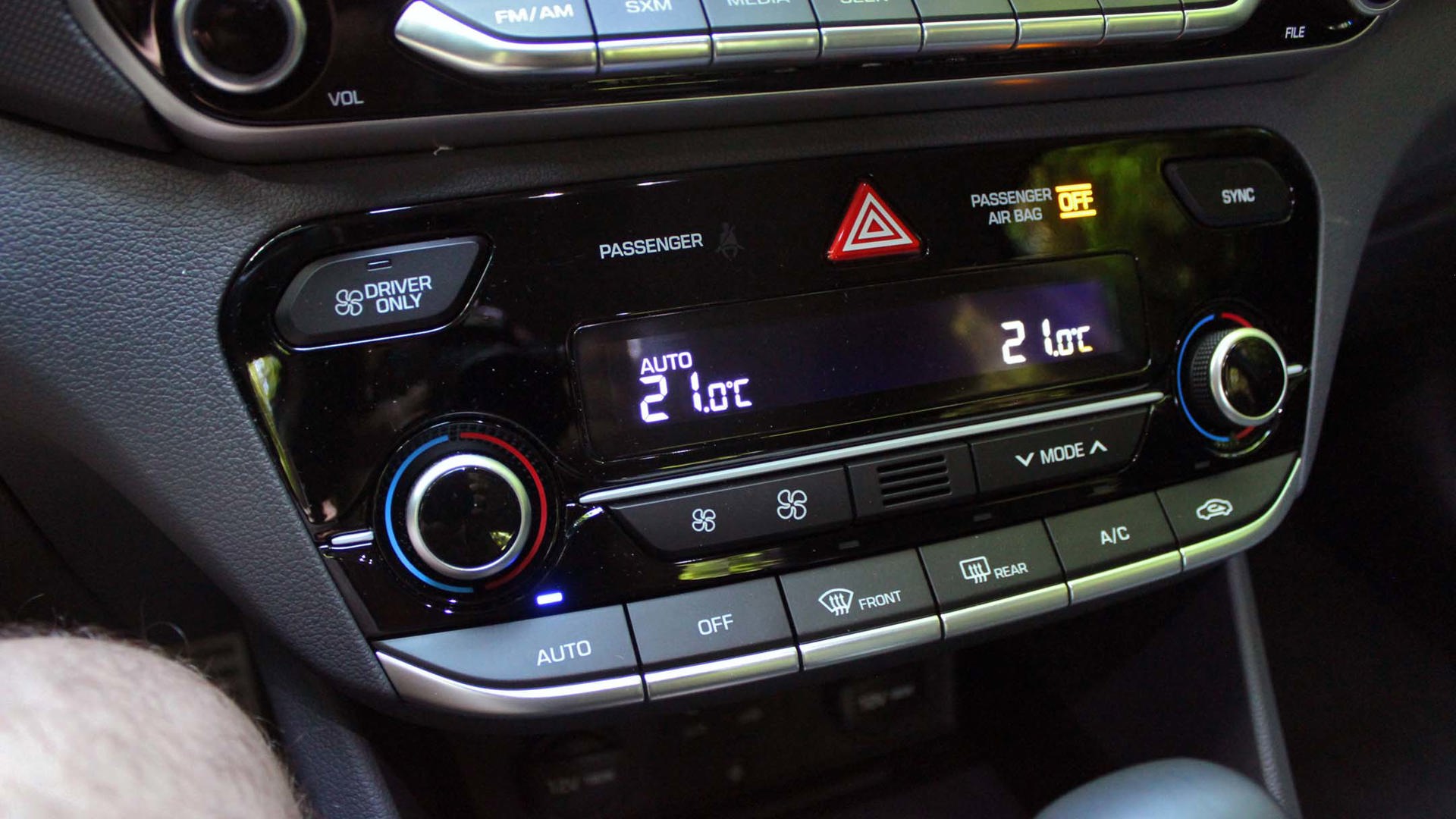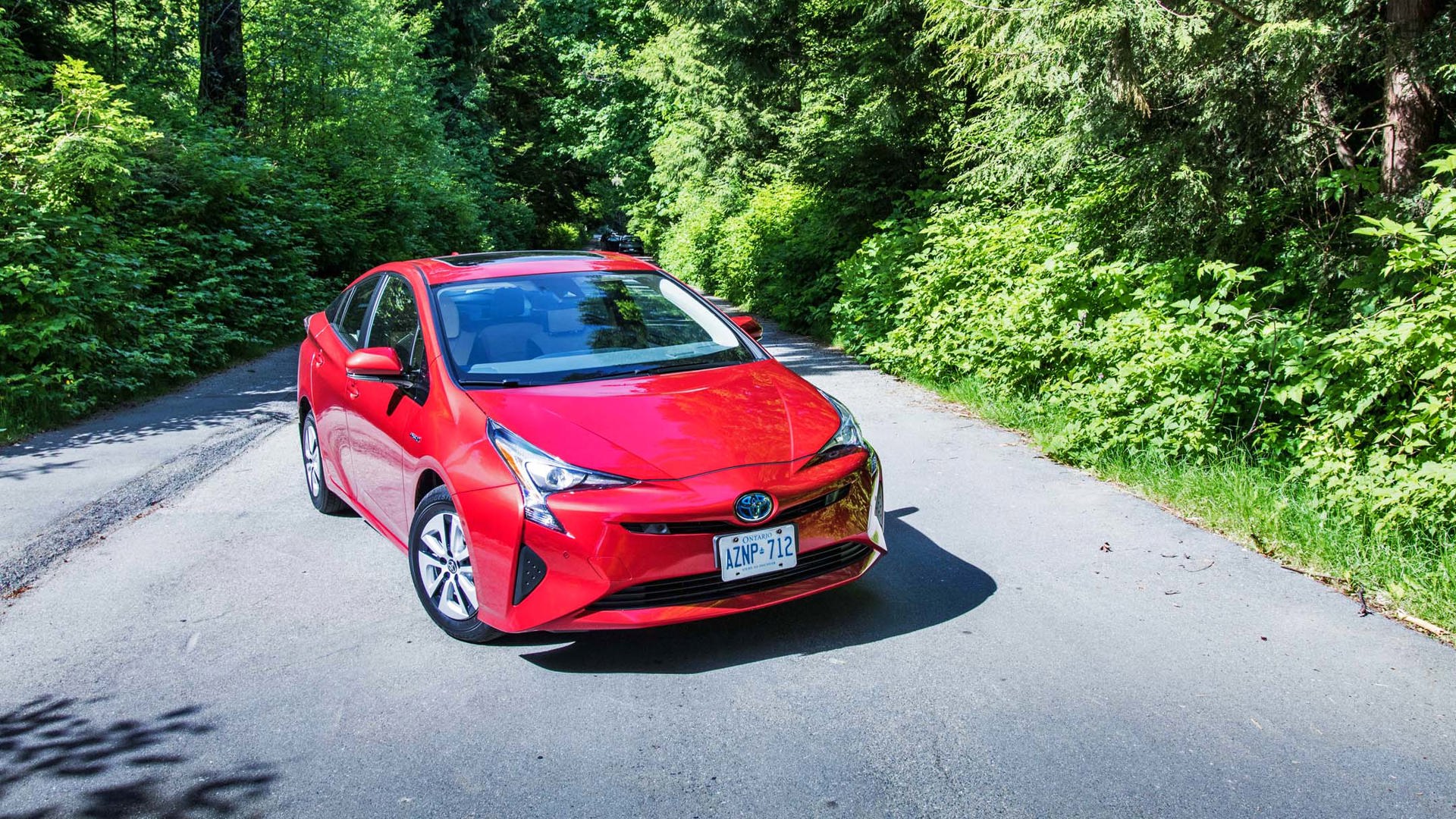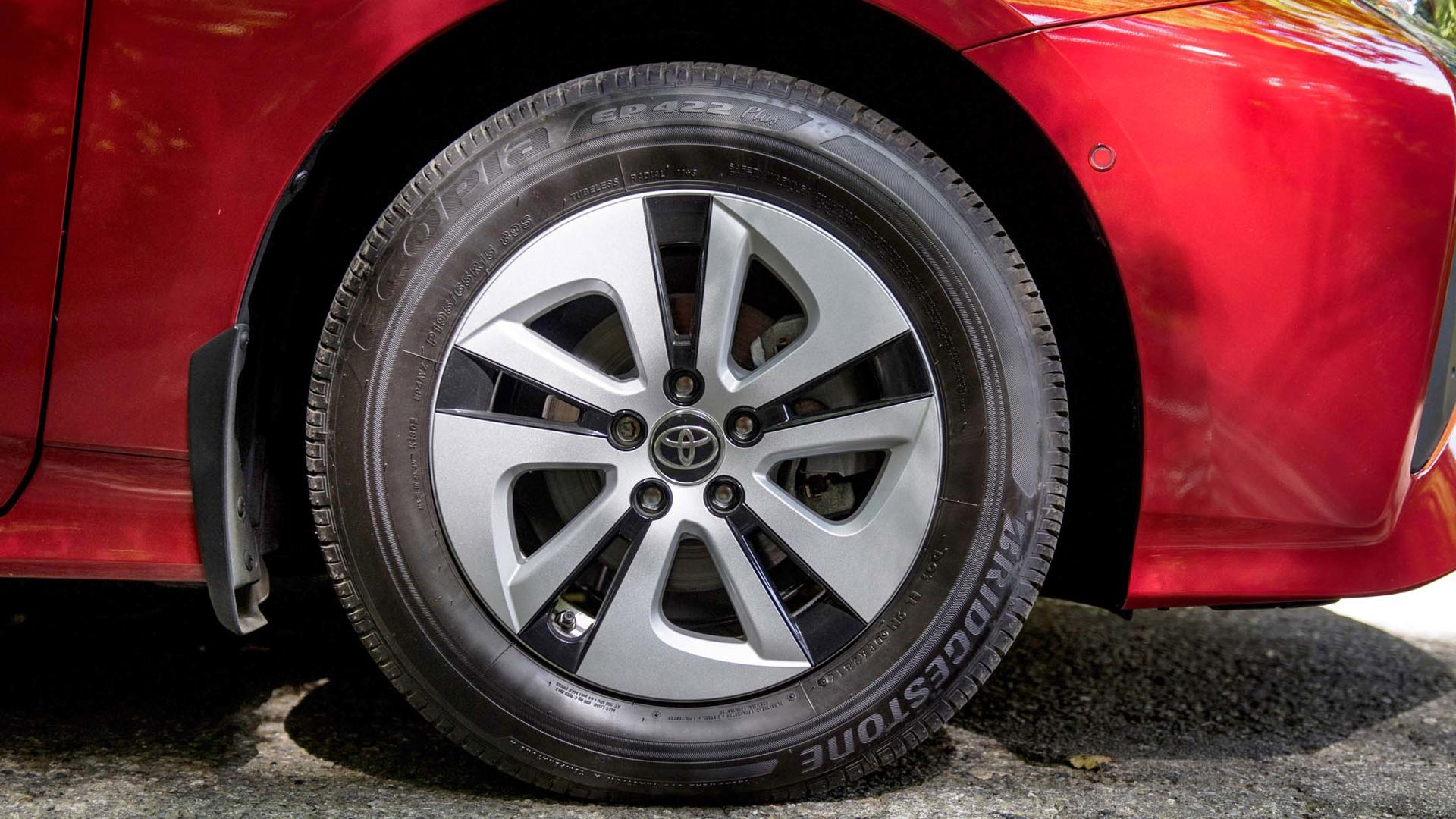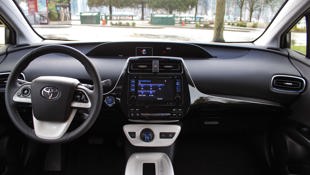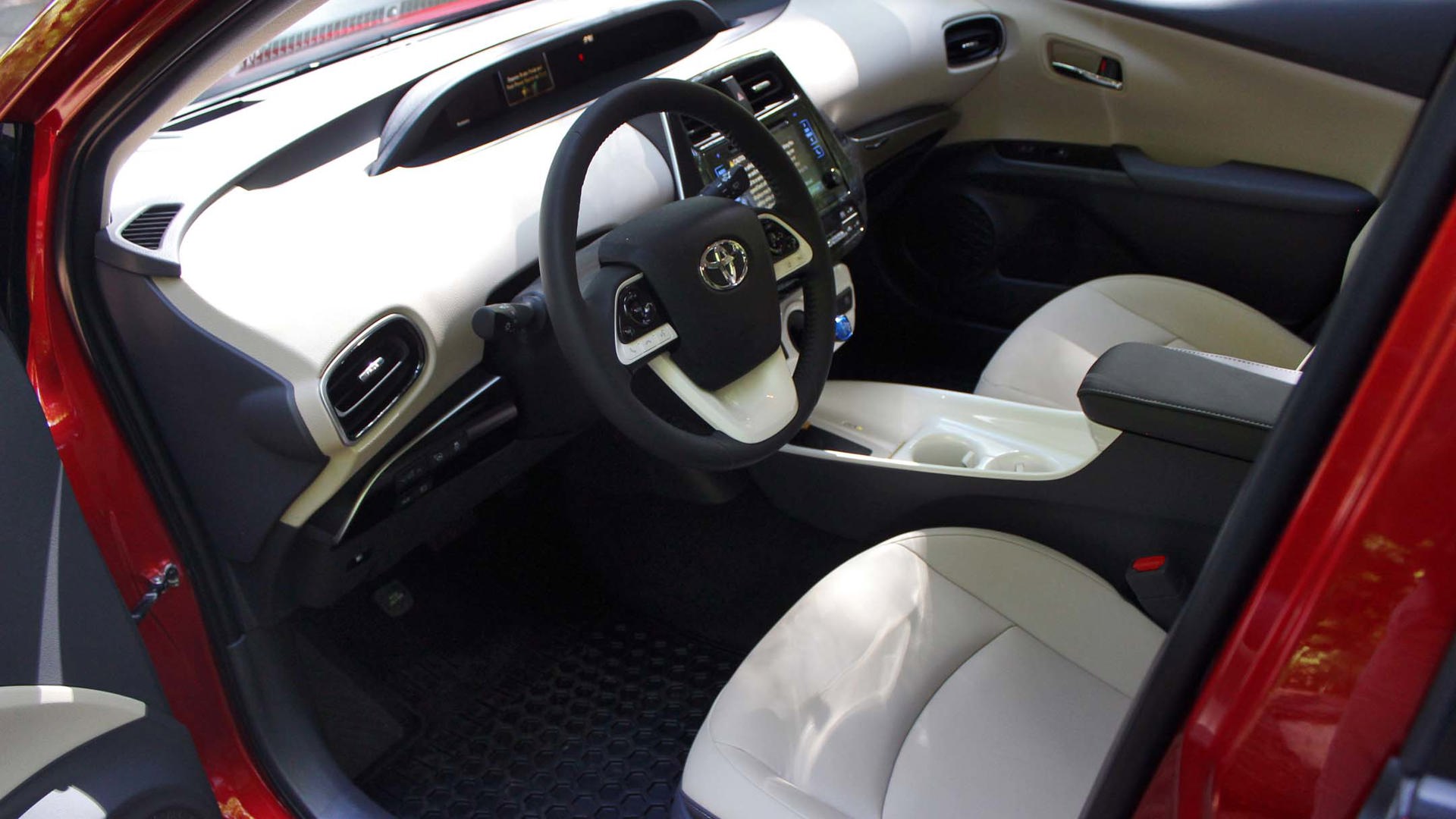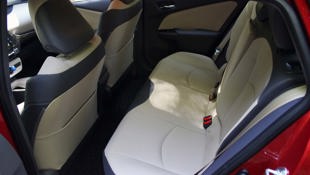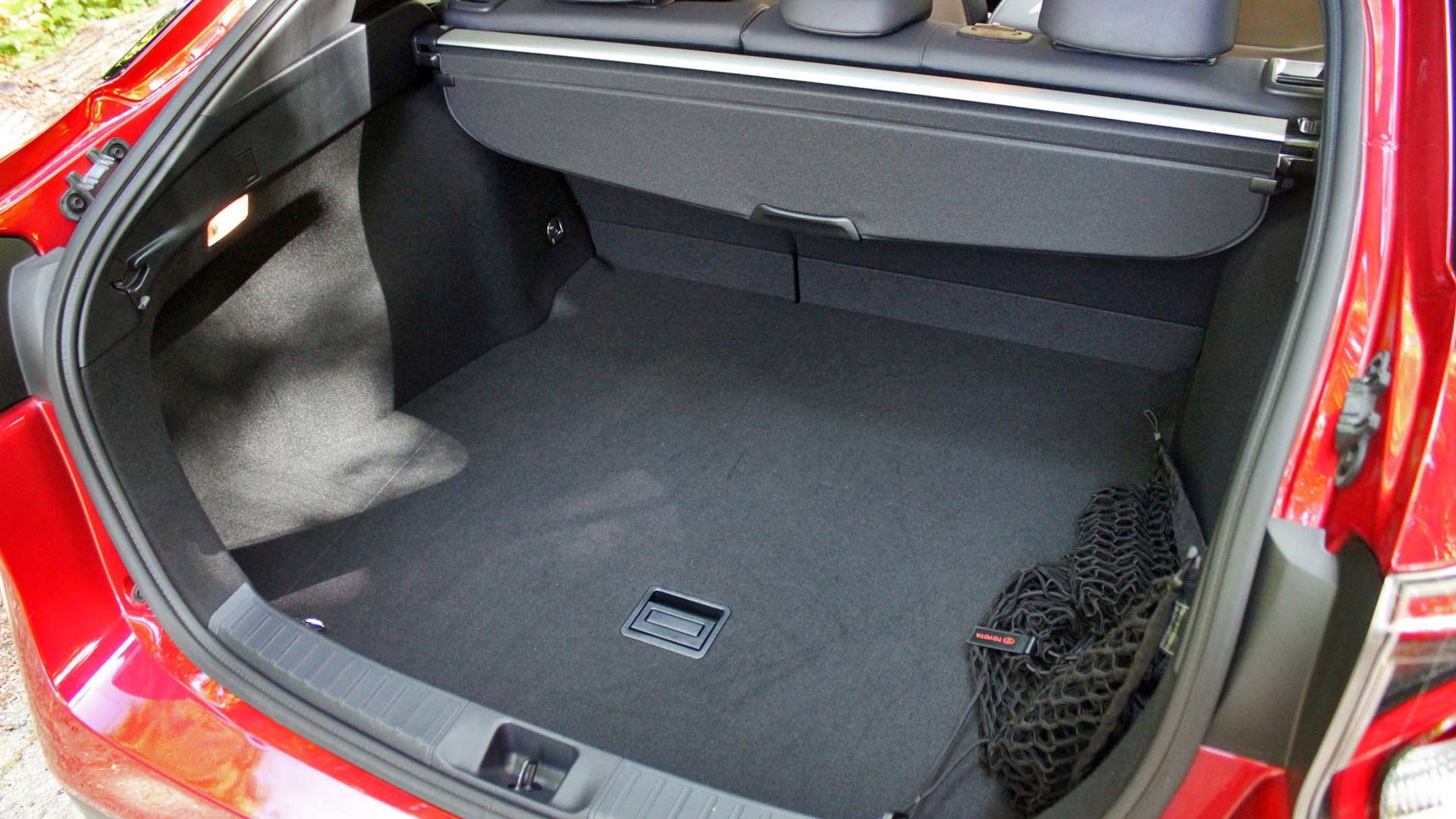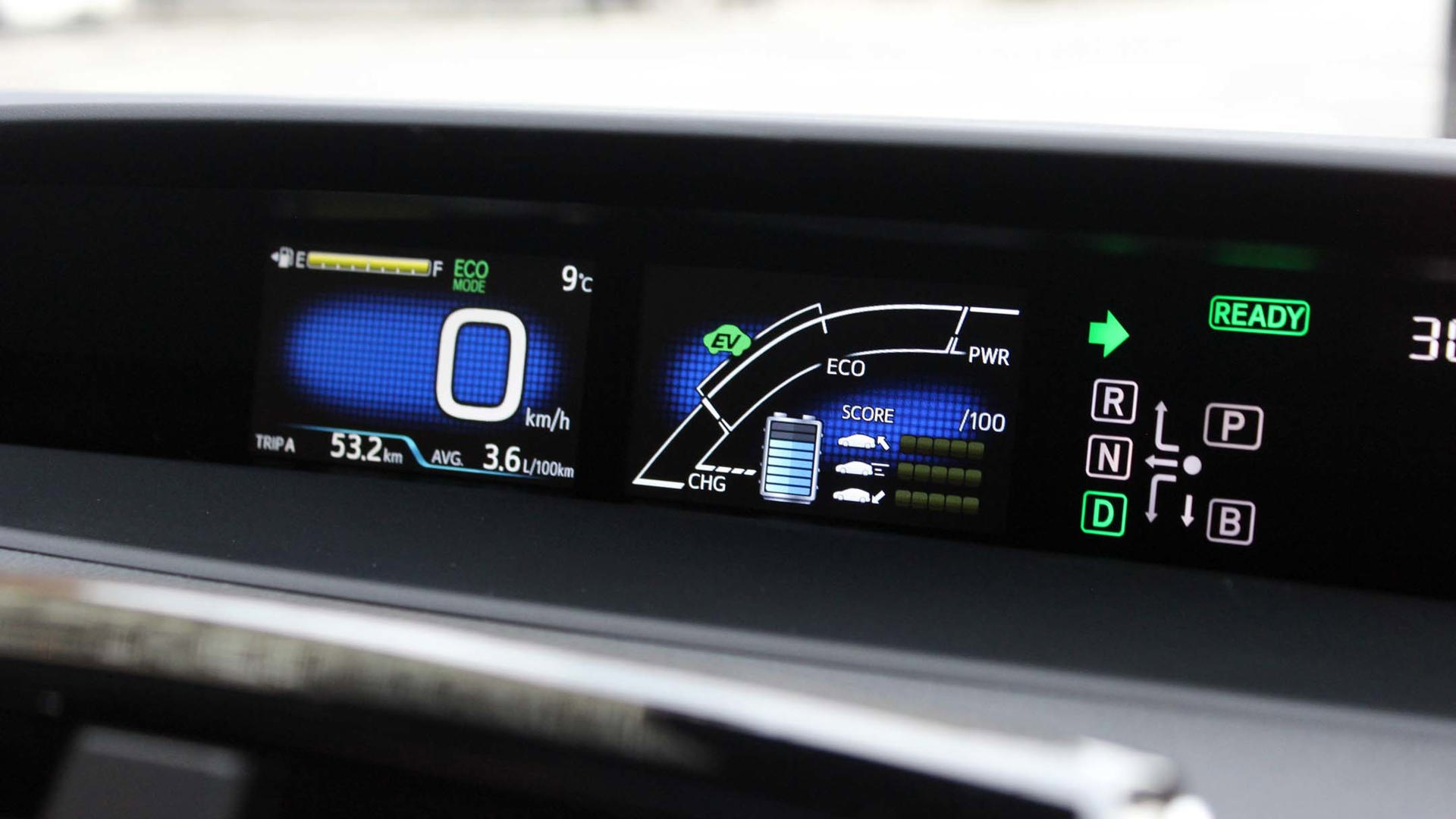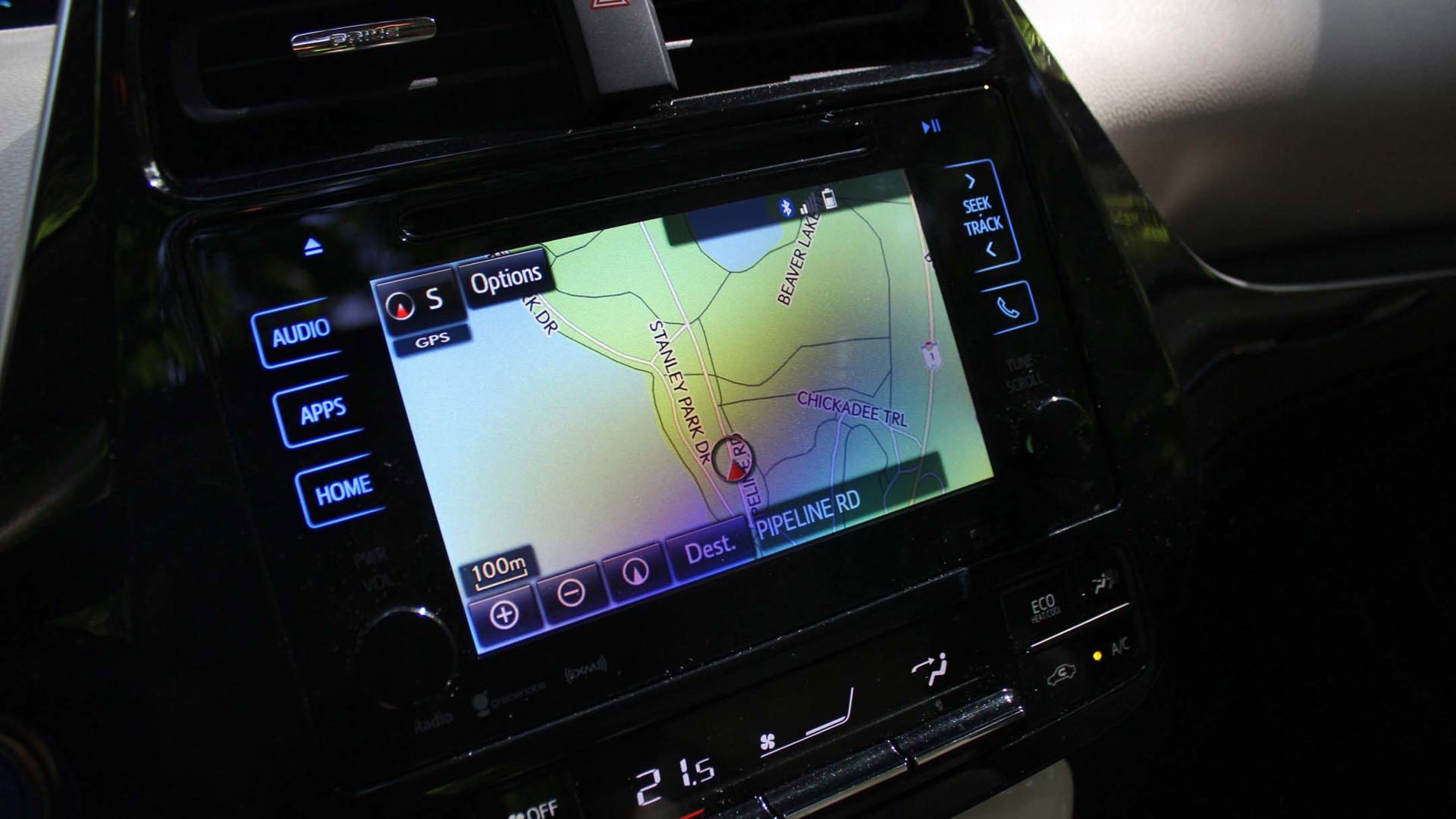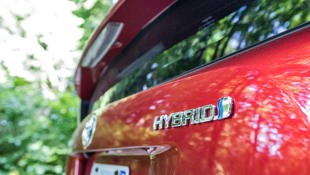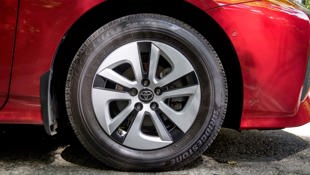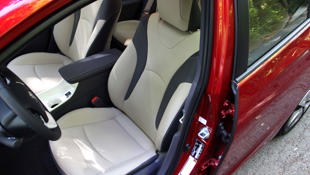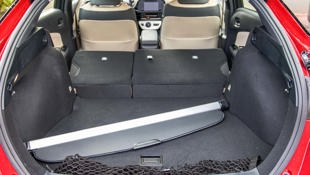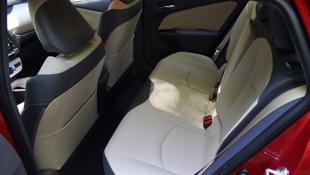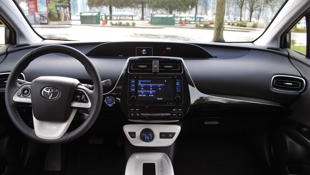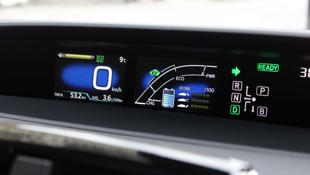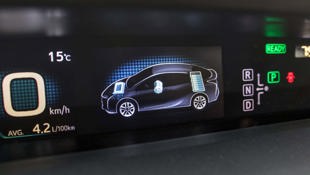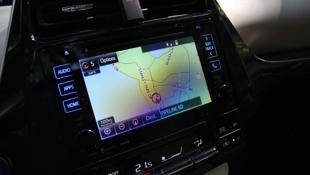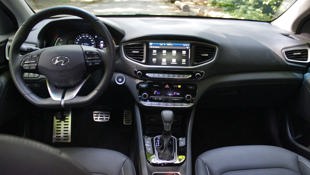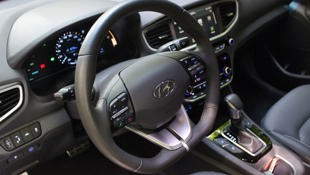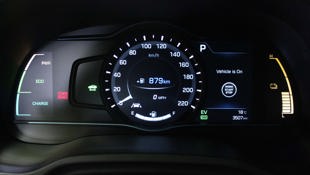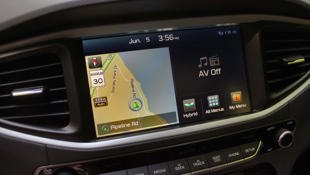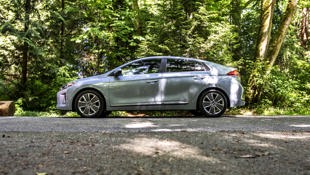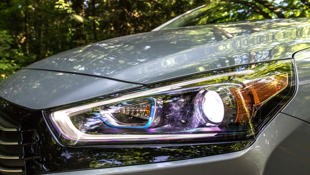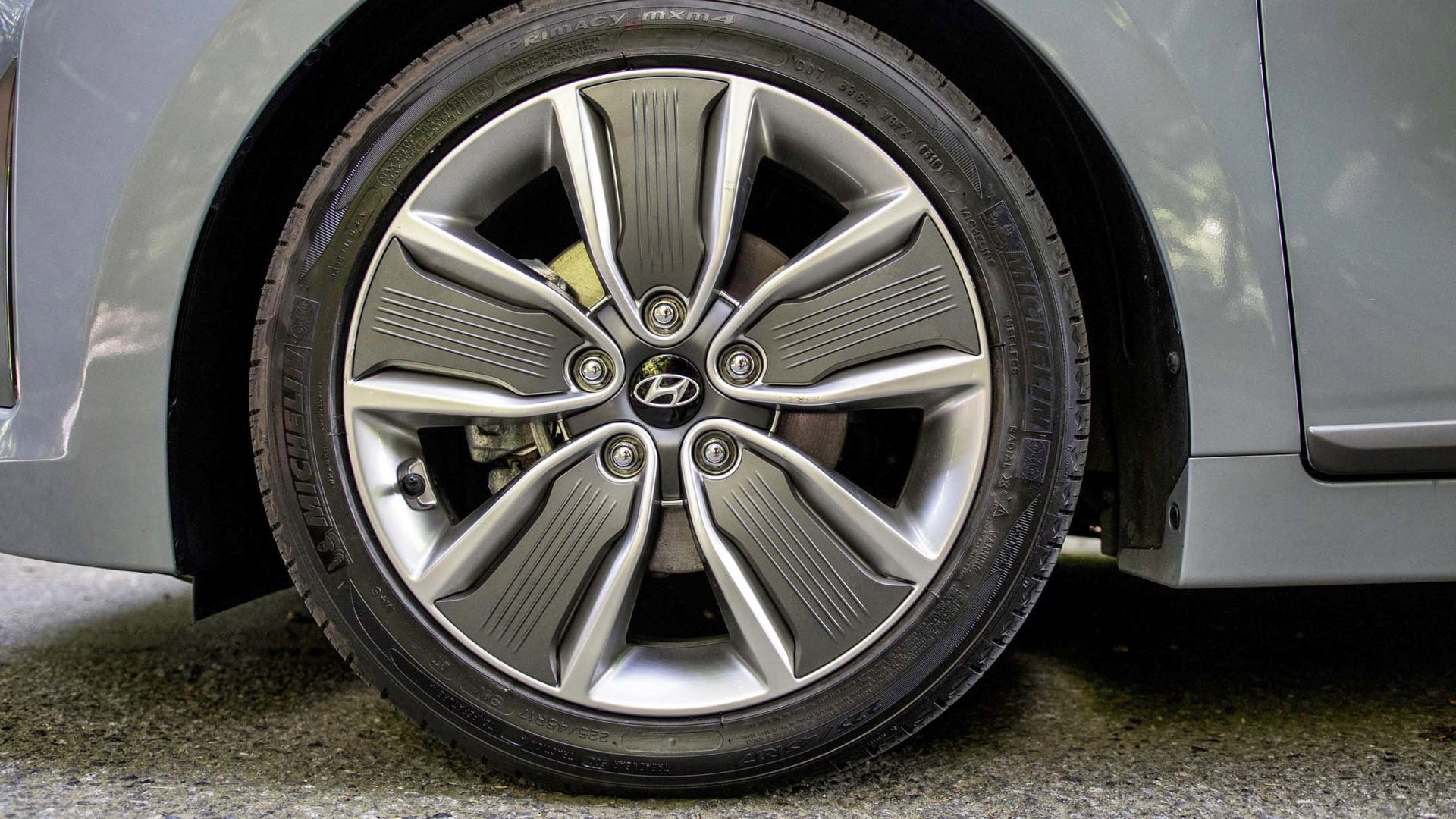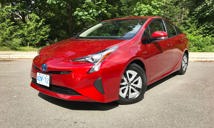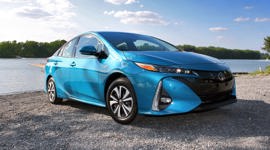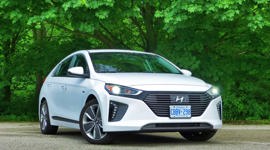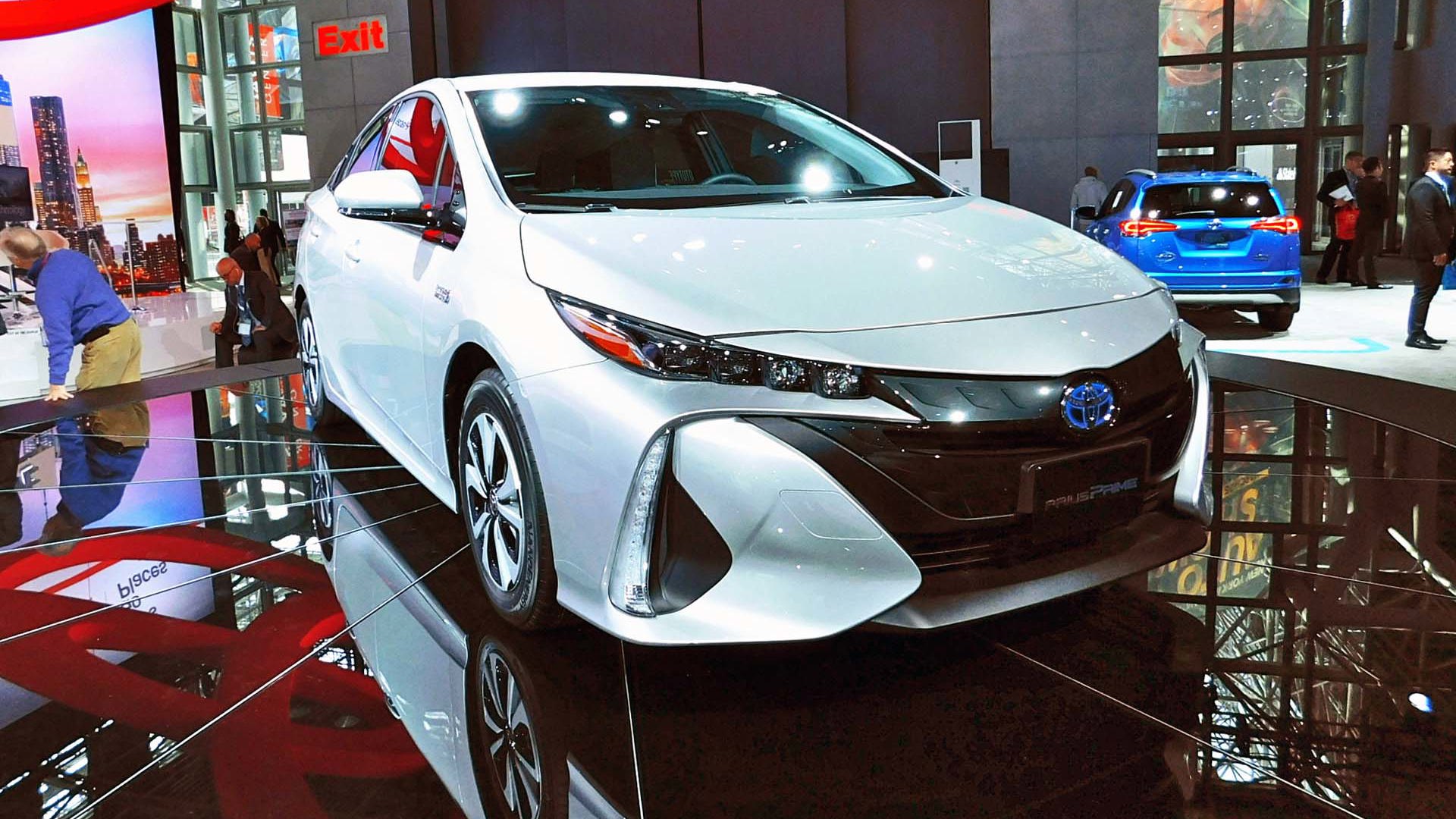Comparison Data
|
2017 Hyundai Ioniq Limited Tech
|
2017 Toyota Prius Technology
|
|---|---|
|
Engine Displacement
1.6
|
1.8
|
|
Engine Cylinders
4
|
4
|
|
Peak Horsepower
139 hp (104 hp gas, 43hp elec.)
|
121 hp (95 hp gas, 71 hp elec.)
|
|
Peak Torque
195 lb-ft (109 lb-ft gas, 125 lb-ft elec.)
|
120 lb-ft (105 lb-ft gas, 120 lb-ft elec.)
|
|
Fuel Economy
4.3/4.4/4.4 L/100 km city/hwy/cmb
|
4.4/4.6/4.5 L/100 km city/hwy/cmb
|
|
Cargo Space
764 L
|
697 L
|
|
Base Price
$31,749
|
$28,730
|
|
A/C Tax
$100
|
$100
|
|
Destination Fee
$1,705
|
$1,690
|
|
Price as Tested
$33,554
|
$34,035
|
|
Optional Equipment
None
|
$3,515 – Advanced Package (power heated seats, Softex, rain-sensing wipers, parking assist, heads-up display) $3,260; optional colour $255
|
Review and photos by Dan Heyman and Brendan McAleer
Dan says:
To best the established eco-champ, it’s not going to be enough for the Ioniq to match Prius values and undercut a little on price. It’s got to bring something different to the table.
Ahh, the venerable Toyota Prius.
One of the pioneers of the hybrid movement – Toyota was one of few to do a hybrid at the outset, but now pretty much every manufacturer has one – it has over the years developed not necessarily a cult following (it’s way too mainstream for that) but a strong following that runs the gamut from taxi cab drivers to movie stars like Leonardo di Caprio and Cameron Diaz.
Indeed, even as the hybrid market has grown, the Prius has kind of managed to exist in a class all its own thanks to its size; many manufacturers are doing hybrid midsize sedans and crossovers, but hybrid compact hatches like this have pretty much boiled down to the Honda Insight (gone), the Prius, and the Chevrolet Volt, although that’s a range-extended EV as opposed to a more traditional hybrid as seen here.
That, however, is no longer the case as Hyundai has come forth with a very worthy competitor in the segment: the Ioniq. Like the Prius, it’s a compact hatch with a cab-forward profile, and like the Prius, it has a whole lineup of cars to its name, though all with the same hatchback body style: the hybrid seen here, a plug-in hybrid, and a full EV model.
Brendan says:
It is, indeed hard to believe that Toyota’s once-futuristic eco-pod is now ubiquitous. If once it was a statement, that statement is now something along the lines of, “I prefer to take the road well-travelled.” With a proven track record for reliability, efficiency, and ease of use comes that traditional Toyota attribute of solid resale values. Picking a Prius isn’t diverging from the mainstream, it is the mainstream. Why would you buy any other kind of hybrid?
Hyundai’s bet is that Prius customers might be looking for something that’s a little more conventional in appearance, both inside and out. If the Prius blazed the trail, then there’s now a way clear for others to take a good look at the market segment and have a shot at carving out their own slice of that pie. Not to mention that adding a couple of green machines to their lineup is good for Hyundai’s brand image.
We’ve seen previously that Hyundai’s progress is remarkable over the last decade or so, whether it’s the ability of Genesis line to challenge established luxury marques like Lexus and Infiniti (and perhaps even BMW and Mercedes), or their convincing attempts to beat out the usual suspect in the sport compact class with the Elantra Sport, in both sedan and hatchback flavours.
Still, the Ioniq has a tough sell here. When it was new, the Prius had to fight an uphill battle to convince the masses, and in doing so it basically became its own brand. Prius owners don’t say, “I own a Toyota hybrid,” they say, “I’ve got a Prius.” To best the established eco-champ, it’s not going to be enough for the Ioniq to match Prius values and undercut a little on price. It’s got to bring something different to the table.
Styling
Brendan says:
First, the good news. One trump card the Ioniq can immediately play is that it doesn’t look like a deranged catfish-based Pokémon. To call the new Prius “polarizing” is an insult to polarizing things. Quite simply, Toyota’s design department appears to have been forced into trying to make what was formerly an inoffensive and crowd-pleasing shape into something aggressive. We do not need an aggressive Prius. That’s like trying to market aggressive tofu.
The Ioniq has a few “Hey, I’m a hybrid!” design cues, such as the wide-spoked, two-tone wheels, and some subtle blue badging. It also appears to have cribbed its split-level rear hatchback glass from the Prius, and I’ll allow it’s not as pretty as the Elantra compact.
But compared to the Prius, the Ioniq is just less weird. Given that Prius buyers are often pretty conservative folks, this alone might be sufficient to push buyers through the doors of Hyundai showrooms. Additionally, supposing someone is in having their ordinary sedan serviced at either a Hyundai or Toyota dealership, respectively, the Ioniq’s more conventional look might convince a few non-shoppers that giving a hybrid a chance might be worth it. Gas prices, in Canada at least, are through the roof.
Quickly running through the details, this Technology package Prius comes with 195-series all-season tires on 15-inch alloy wheels, and LED headlights and taillights; fog-lights and 17-inch alloys are available on the Touring model for an extra $600. Our Limited with Tech Ioniq has 17s, 225-series tires, and adaptive LED headlights, but costs about the same as the Touring (more basic models come with 15s similar to the Prius).
Interior/Comfort
Dan says:
While the two cars are similar in size, the Prius just edges out the Ioniq here. Yes, the colour of the Prius’ interior is a little deceiving, its brighter colour making it look bigger to the eye. Light colour or no, though, it’s airier in the Prius than it is in the Ioniq, even though they’re virtually identical size-wise.
Looks-wise, the choice is going to come down to whether you’re looking for some more futuristic environs, or something a little more traditional. I guess you could say that it’s a little ironic that the newcomer here – though the Prius was technically all-new for the 2016 model year – is actually the more traditional-looking, both inside and out.
Me? While I like the Prius’ airiness and the digital displays above the dash as opposed to directly ahead of you, those white plastic inserts simply have got to go. They show every little dust particle that may find its way to their surface (same goes for centre stack’s super-shiny piano black surround), and they just cheapen the whole experience. Unfortunately, it’s offered no other way. It’s a shame.
Having said that: I wouldn’t say the Ioniq looks old, not by any means. The gauge cluster may occupy a more traditional spot behind the steering wheel, but it is fully digital, which I rather like. Same goes for the main infotainment display; the colours are bright and the graphics are sharp, making for something that seems altogether more modern than what’s offered by the Prius.
Storage-wise, both cars are good in that they offer big hatches with huge openings, as well as easy-fold rear seating. You may think the slanted rear decks of each car make for an overly shallow cargo area, but there’s surprising depth here and a very low liftover height on each.
I’m also a big fan of the Ioniq’s driver seat position. As a six-foot-plus guy, I often feel like I’m sitting on top of cars as opposed to inside them, but that’s simply not the case with the Ioniq. The dash is low enough for a good view out, but not so low that I felt perched atop the whole shebang. Same goes for the view out over the shoulders, which is nicely unrestricted even with that great profile shape.
The Prius is pretty good, too, but the dash ahead of me feels huge even though I felt like I was sitting higher overall. It’s a weird mix of perspectives. The steering wheels on both cars tilt and telescope, but the Ioniq’s offering has a larger range of movement than the Prius’, another contributing factor to the former’s win in the ergonomics department.
Brendan says:
I’ll offer a quick summation here: the Ioniq’s interior looks like that of a normal car; the Prius looks like that of a Prius. And yes, the white inserts of the latter are a bit weird. It looks like somebody installed a bidet in the centre console.
Tech
Dan says:
Being the top trims of both their respective model lines, both cars come with all manner of bells and whistles to satiate the techie in any of us.
First of all, the obvious: the Ioniq gets the bigger infotainment screen of the two, and as I mentioned earlier, it’s nicer to look at too. The Prius’ system is fine to operate, but in futuristic cars like these, you want the bright lights and whiz-bangery in your infotainment system to be top trumps. Plus, the system in the Prius is no easier to operate than the Ioniq’s; in fact, it’s a little tougher if you prefer more traditional button controls, since it’s an all-touch affair. Oh, and there’s also no support for Apple CarPlay or Android Auto, which is becoming a bigger and bigger no-no these days. The Prius, however, makes up for its smaller screen by adding a head-up display, which is something Hyundai doesn’t offer for the Ioniq, no matter the trim.
Our Ioniq tester being the Limited with Tech package trim, we also had eight-speaker Infinity audio, which is a plus-two count over what’s offered by the Prius, even if you spec the top Prius Touring trim. The Ioniq’s system sounds markedly better as a result, whether you’re listening to Bluetooth audio or AM radio. When you think about it, eight speakers is quite the count when you consider the compact environs of the Ioniq.
Both vehicles, of course, make use of their infotainment screens for more than just that; they’re also where you’ll find your power-flow meters, always important in hybrids. If the Ioniq wins out for its general display, the Prius takes the cake in this regard. Its system is a lot easier to follow and while the Hyundai system may look slick, I found it much tougher to understand exactly what my powertrain was doing.
Safety-wise, there’s once again little to differentiate between the two: adaptive cruise control, forward collision warning with pedestrian detection, lane-departure warning system, blind-spot warning system are all present, but the Prius edges the Ioniq out in a key way: Toyota’s Safety Sense package – basically, the umbrella name for all these features – is standard on all trim levels. You have to upgrade up two levels from base to get the same in the Ioniq. While each car’s various safety systems work well, that’s a big value-add for Toyota.
Brendan says:
We’ll get to value in a bit, but the point Dan just touched on here – Toyota’s Safety Sense as standard equipment – is worth a little more of a deep dive. Without wishing to be ageist, the former Prius made a lot of sense for an older driver in an urban setting, perhaps an empty-nester with the kids finally out of the house. It was frugal, it was comfortable and quiet, and a medium-sized dog fit perfectly in the back. Throw in low maintenance and modest fuel usage, and you had a winner.
The fact that Toyota is making their driving aids standard is to be commended. Autonomous cars get the headlines about the future, but semi-autonomous features are what are going to make the difference in traffic safety right now. Being able to buy a basic Prius and get the best safety possible without having to pony up for tech features you might never use is great news for the consumer.
Performance and Handling
Dan says:
This is where the two cars really start to separate. Not that one is clearly better in this regard than the other; each is good for very different reasons.
In keeping with the theme of more comfort provided by the Prius, the overall ride is superior to the Ioniq. Bumps are swallowed up with gumption, and while you’re going to sense some body roll as you put it through the bends, Toyota did a masterful job of curbing this for this Prius generation. How well it soaked up even what appeared to be big bumps – caved-in concrete, train tracks – continued to surprise me throughout my drive, feeling much more like a Camry than a Corolla.
It’s not going to be the most engaging drive, however. That crown falls squarely on the Ioniq’s roof. Like the Honda Accord Hybrid, the Ioniq is a hybrid that simply doesn’t drive like you’d think it would. It’s more engaging on throttle, turn-in is crisper, and the brakes are very responsive.
When it comes to the handing, you can thank the Ioniq’s multi-link rear setup for the responsiveness, where the Prius makes do with a more standard double-wishbone offering, Both cars get MacPherson struts up front, but you wouldn’t think so the minute you twist the wheel. Which, as it happens, gets a very sports car-like flat bottom in the Ioniq. See? Even from looking at the wheel, you can tell the Ioniq is the sportier offering. Is it necessary? Will your thighs not have enough room between seat and wheel if it weren’t for the flat bottom? Probably not the case, but I think it’s a cool add.
Not only does the Ioniq perform well in the handling department, it also eclipses the Prius for power, making 152 combined horsepower to the Prius’ 121. Both cars, of course, can operate in full EV mode for a spell, but only the Prius lets you actually select EV-only, as long as you have enough battery power reserved to do so, and you’re not travelling much more than 60 km/h. I did, however, find the Prius a little more willing to cruise in full-EV mode for longer periods of time during our test, even though both cars use Atkinson-cycle engines with similar EV capacity.
The Prius is also the subtler of the two when it comes time to getting the 1.6L gas engine on-line; the Prius’ 1.8L unit is quieter in its operation, perhaps because it doesn’t have to work quite as hard to get the car moving. It’s a bit of a double-whammy for the Ioniq: it has a smaller gas engine, but also weighs more than the Prius. Surprising, considering the latter is larger overall.
The feeling of “performance add” is multiplied when you consider each car’s transmission: the Prius makes do with a very hybrid-appropriate CVT, while the Ioniq gets a six-speed dual-clutch automatic that actually has a manual-shifting option. For its part, the Prius gets a sport mode, but it isn’t quite the same, taking the reins off a little bit and allowing for brisker forward progress. In place of the Ioniq’s sport slot, however, the Prius gets a “B” slot (if you can call it a “slot”; the Prius uses a gear toggle that’s much more a switch than an actual mechanical lever), which allows for some engine braking on downhills to take some strain off the brakes themselves.
It may be strange to be talking about these cars with any modicum of performance bent, but the Ioniq is so surprisingly able in that department that it merits the conversation. During the test, Brendan and I agreed that the Prius is better at being a “hybrid”, that being its calling card. That, and the smoother ride. The Ioniq is here for the hybrid buyer that wants a little more from the drive, and there’s nothing wrong with that.
Brendan says:
Again, what Hyundai offers is a driving experience that matches its interior and exterior. For someone coming out of a conventional gasoline-powered car, the quick-shifting dual-clutch is far more pleasing than the Prius’ rubber-band continuously variable transmission – and the power delivery is prompt. The Ioniq doesn’t require explanation, it mostly works behind the scenes to effectively disguise its fuel-saving roots.
The Prius doesn’t, but perhaps that’s a feature, not a demerit. At the end of our day running across town to the airport, the Prius displayed a mild fuel economy advantage over the Hyundai, and I’d argue part of the edge was due to the pillowy softness of Prius dynamics. Don’t take this the wrong way, Toyota, but driving a Toyota is a bit like falling into the ball pit at Ikea. Sure, you thrash around at first, but eventually you just relax.
Were this a shootout between two sporting machines, we’d be looking for grip, power, and handling. If it was a luxury car contest, comfort and prestige would be the ultimate deciding factors. In the case of hybrid versus hybrid, a car that forces the driver into a more efficient driving style deserves kudos for doing so. Presumably you bought the thing to save fuel in the first place.
And, having said that, the Prius is slightly more fun to drive than the old model. Slightly. The improved rear suspension helps out, and the mid-range torque comes on a little more readily. It’s not the automotive hair shirt it used to be in the early cars.
The difference is that the Ioniq’s dynamics don’t really enter into your thoughts much, just as its interior layout does not, and just as its exterior does not. People won’t say, “I drive an Ioniq,” they’ll say, “I drive a Hyundai.” It’s not so much that it’s the more fun car to drive; it’s the more car-like car to drive.
Value
Dan says:
We talked before about how the Prius gets a big boost in this department thanks to the standard fitment of Toyota Safety Sense, no matter which of the three trims – Prius, Prius Technology and Prius Touring – you select.
Having said that: the Ioniq starts almost $3,000 less than the Prius – at under 25 grand, it’s a great gateway into the hybrid world, especially if you’re treating it as a second (or third) car, or perhaps even your first car.
Yes, the Prius exhibited slightly better fuel economy than the Ioniq, but when you’re talking less than 1.0 L/100 km difference, it’s hardly a deal-breaker as both cars are going to sip fuel as if we were running out of it. Which, to many, we are.
Yes, I guess the Prius’ easier ability to cruise in EV mode is a selling point for some – especially if you like the ability to overrule the system and select EV yourself – but again, these are some very split hairs. On cost of entry alone, the Ioniq wins.
Brendan says:
I’m going to argue that it’s not quite so clear-cut. The Hyundai is a Hyundai and the Prius is a Prius. The latter convinced most people a while ago, and should retain a greater percentage of its value than the Ioniq. Yes, the Santa Fe does well in the used market, but the Ioniq is a new factor.
While the Ioniq’s 5.2L/100km observed consumption was more than a tad higher than the Prius’ right-on-the-money 4.4 L/100km, note that official specs peg these two at nearly identical in mixed mileage. I’d bet the differences is down to the Ioniq’s wider tires and the Prius’ Xanax effect on the driver.
Still, $3,000 less to start is nothing to sneeze at. Base to base, I’d probably look pretty strongly at the Prius, which has Toyota Safety Sense as standard, as the overall value proposition. Get into the mid-range, and the equipment level on the Ioniq means it’ll get considered against more conventional sedans. There’s good value here, as you’d expect from a Hyundai product.
Conclusion
Dan says:
Does it win overall, though? Has it managed to overthrow the veteran, the old stalwart of the hybrid hatch game? To the win in value for the Ioniq I’ll add a win in looks; the Prius has gotten quite the response since its release, not a lot of it all that glowing. It’s a wild thing to look at, but they may have taken it just a little too far with those crazy headlight lenses.
Thing is, you don’t see all that when you’re inside, driving; all you should really care about then is how comfortable you are, how happy behind the wheel, and the Prius definitely delivers on that front. Plus, it’s got that great name that is so popular, it may as well be a sub-brand for Toyota, à la Lexus. That’s an important factor that many will consider, especially when we start talking resale values.
As I step back, however, and just think about which car I would be happier owning, driving every day and greeting me as I open the garage door in the morning, the Ioniq takes it. It presents great value, it looks good and the tech on offer is top notch. The Prius will continue to have its followers, sure, but don’t be surprised if the Ioniq takes a generous slice of the hybrid hatch pie.
Brendan says:
First, that’s a pretty small pie, and perhaps a shrinking one in the total North American market. The fact that you can buy the Ioniq as a full EV is something else to consider, especially if your commute is almost entirely urban. I wouldn’t be surprised if Hyundai has a few more surprises down the line here, especially as Toyota seems convinced that hydrogen fuel cells are the way to go.
Also, the Prius is going to outsell the Ioniq for a good while yet, no matter the looks. It’s the established marque, and Hyundai shouldn’t expect to unseat it for a while. They’ll be lucky if they sell a fifth as many Ioniqs by the end of the year as Toyota does Priuses. Prii. Whatever.
Having said that, I’m on board with Dan here, in that the Ioniq is the way I’d spend my own money. I prefer the way it drives, I enjoy the comfort. Also, and I’m probably not alone here, I’d rather not look out and see a catfish in my driveway every morning.
